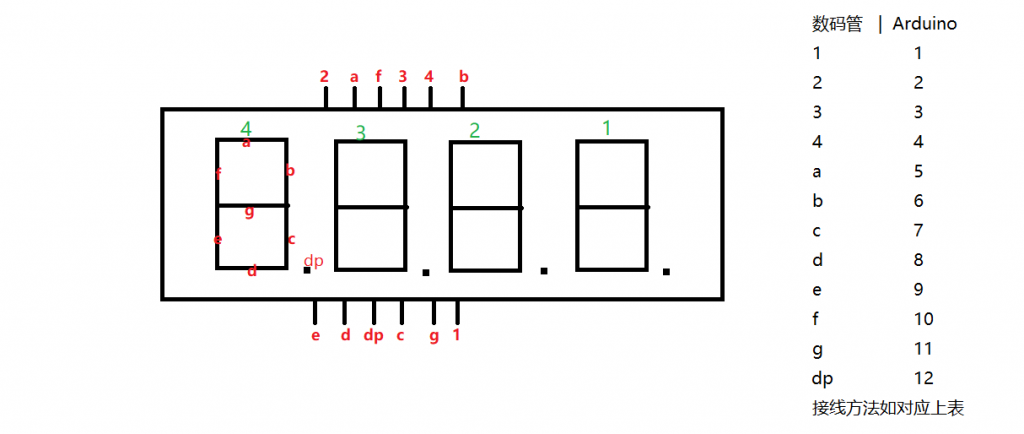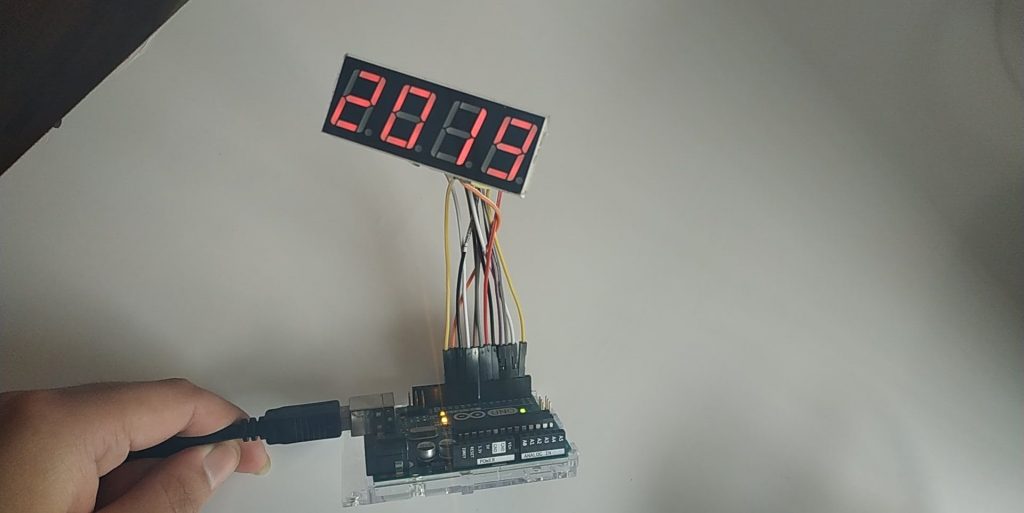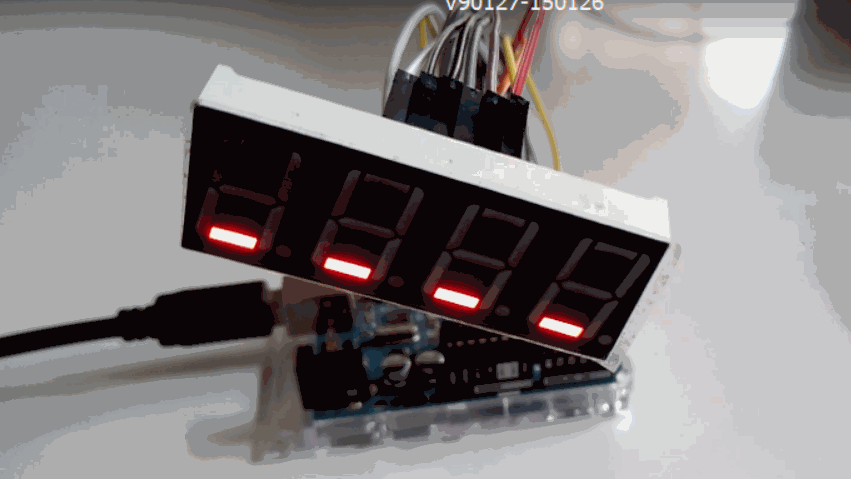由于树莓派被LCD1602占据,所以只好先在Arduino上驱动四位数码管了。

上图是网上查找的四位数码管管脚定义图
后来发现这张图和我手上的数码管有出入!
我的数码管针脚定义如下

four_digits_tube_driver.ino
/*
// Four Digits Tube Driver(common anode)
// Last-Modified:2019-1-27 13:28:00
// Copyright (C) 2019 SENCOM <sencom1997@outlook.com>
//
// This program is free software; you can redistribute it and/or modify
// it under the terms of the GNU General Public License as published by
// the Free Software Foundation; either version 3 of the License, or
// (at your option) any later version.
//
// This program is distributed in the hope that it will be useful,
// but WITHOUT ANY WARRANTY; without even the implied warranty of
// MERCHANTABILITY or FITNESS FOR A PARTICULAR PURPOSE. See the
// GNU General Public License for more details.
//
// You should have received a copy of the GNU General Public License
// along with this program. If not, see <http://www.gnu.org/licenses/>.
*/
const int pin_w[4] = {1,2,3,4}; // 四位位选(高电平有效)
const int pin_n[8] = {5,6,7,8,9,10,11,12}; // 八位数字产生(低电平有效)
const int n_0[8] = {0,0,0,0,0,0,1,1}; // 0~9 数字
const int n_1[8] = {1,0,0,1,1,1,1,1};
const int n_2[8] = {0,0,1,0,0,1,0,1};
const int n_3[8] = {0,0,0,0,1,1,0,1};
const int n_4[8] = {1,0,0,1,1,0,0,1};
const int n_5[8] = {0,1,0,0,1,0,0,1};
const int n_6[8] = {0,1,0,0,0,0,0,1};
const int n_7[8] = {0,0,0,1,1,1,1,1};
const int n_8[8] = {0,0,0,0,0,0,0,1};
const int n_9[8] = {0,0,0,0,1,0,0,1};
#define SLEEP 500 //延时
void setup()
{ //初始化
for(int i = 0; i < 4; i++)
pinMode(pin_w[i], OUTPUT);
for(int i = 0; i < 8; i++)
pinMode(pin_n[i], OUTPUT);
}
void print_a_number(int n) //输出 一位数字
{
switch(n)
{
case 0:
for(int i = 0; i < 8; i++)
digitalWrite(pin_n[i],n_0[i] );break;
case 1:
for(int i = 0; i < 8; i++)
digitalWrite(pin_n[i],n_1[i] );break;
case 2:
for(int i = 0; i < 8; i++)
digitalWrite(pin_n[i],n_2[i] );break;
case 3:
for(int i = 0; i < 8; i++)
digitalWrite(pin_n[i],n_3[i] );break;
case 4:
for(int i = 0; i < 8; i++)
digitalWrite(pin_n[i],n_4[i] );break;
case 5:
for(int i = 0; i < 8; i++)
digitalWrite(pin_n[i],n_5[i] );break;
case 6:
for(int i = 0; i < 8; i++)
digitalWrite(pin_n[i],n_6[i] );break;
case 7:
for(int i = 0; i < 8; i++)
digitalWrite(pin_n[i],n_7[i] );break;
case 8:
for(int i = 0; i < 8; i++)
digitalWrite(pin_n[i],n_8[i] );break;
case 9:
for(int i = 0; i < 8; i++)
digitalWrite(pin_n[i],n_9[i] );break;
}
}
void print_number(int nums) //输出一个数字(最多四位)
{
int num[4];
for(int i = 3; i >= 0; i--)
{
num[i] = nums % 10;
nums /= 10;
}
for(int i = 0; i < 4; i++)
{
digitalWrite(pin_w[i], HIGH);
for(int k = 0; k < 4; k++)
{
if(k != i)
digitalWrite(pin_w[i], LOW);
}
print_a_number(num[i]);
}
}
}
void loop()
{
}
example_print_number.ino
/*
// Four Digits Tube Driver(common anode)
// Last-Modified:2019-1-27 13:28:00
// Copyright (C) 2019 SENCOM <sencom1997@outlook.com>
//
// This program is free software; you can redistribute it and/or modify
// it under the terms of the GNU General Public License as published by
// the Free Software Foundation; either version 3 of the License, or
// (at your option) any later version.
//
// This program is distributed in the hope that it will be useful,
// but WITHOUT ANY WARRANTY; without even the implied warranty of
// MERCHANTABILITY or FITNESS FOR A PARTICULAR PURPOSE. See the
// GNU General Public License for more details.
//
// You should have received a copy of the GNU General Public License
// along with this program. If not, see <http://www.gnu.org/licenses/>.
*/
const int pin_w[4] = {1,2,3,4}; // 四位位选(高电平有效)
const int pin_n[8] = {5,6,7,8,9,10,11,12}; // 八位数字产生(低电平有效)
const int n_0[8] = {0,0,0,0,0,0,1,1}; // 0~9 数字
const int n_1[8] = {1,0,0,1,1,1,1,1};
const int n_2[8] = {0,0,1,0,0,1,0,1};
const int n_3[8] = {0,0,0,0,1,1,0,1};
const int n_4[8] = {1,0,0,1,1,0,0,1};
const int n_5[8] = {0,1,0,0,1,0,0,1};
const int n_6[8] = {0,1,0,0,0,0,0,1};
const int n_7[8] = {0,0,0,1,1,1,1,1};
const int n_8[8] = {0,0,0,0,0,0,0,1};
const int n_9[8] = {0,0,0,0,1,0,0,1};
#define SLEEP 500 //延时
void setup()
{ //初始化
for(int i = 0; i < 4; i++)
pinMode(pin_w[i], OUTPUT);
for(int i = 0; i < 8; i++)
pinMode(pin_n[i], OUTPUT);
}
void print_a_number(int n) //输出 一位数字
{
switch(n)
{
case 0:
for(int i = 0; i < 8; i++)
digitalWrite(pin_n[i],n_0[i] );break;
case 1:
for(int i = 0; i < 8; i++)
digitalWrite(pin_n[i],n_1[i] );break;
case 2:
for(int i = 0; i < 8; i++)
digitalWrite(pin_n[i],n_2[i] );break;
case 3:
for(int i = 0; i < 8; i++)
digitalWrite(pin_n[i],n_3[i] );break;
case 4:
for(int i = 0; i < 8; i++)
digitalWrite(pin_n[i],n_4[i] );break;
case 5:
for(int i = 0; i < 8; i++)
digitalWrite(pin_n[i],n_5[i] );break;
case 6:
for(int i = 0; i < 8; i++)
digitalWrite(pin_n[i],n_6[i] );break;
case 7:
for(int i = 0; i < 8; i++)
digitalWrite(pin_n[i],n_7[i] );break;
case 8:
for(int i = 0; i < 8; i++)
digitalWrite(pin_n[i],n_8[i] );break;
case 9:
for(int i = 0; i < 8; i++)
digitalWrite(pin_n[i],n_9[i] );break;
}
}
void print_number(int nums) //输出一个数字(最多四位)
{
int num[4];
for(int i = 3; i >= 0; i--)
{
num[i] = nums % 10;
nums /= 10;
}
for(int i = 0; i < 4; i++)
{
digitalWrite(pin_w[i], HIGH);
for(int k = 0; k < 4; k++)
{
if(k != i)
digitalWrite(pin_w[i], LOW);
}
print_a_number(num[i]);
}
}
void tube_dance(int spd)
{
for(int i = 0 ;i < 4; i++) //四位同输出
{
digitalWrite(pin_w[i], HIGH);
}
digitalWrite(pin_n[6],HIGH); //禁用h 和 dp
digitalWrite(pin_n[7],HIGH);
for(int i = 0; i < 6; i++)
{
for(int j = 0; j < 6; j++)
{
if(j == i)
digitalWrite(pin_n[j],LOW);
else
digitalWrite(pin_n[j],HIGH);
}
delay(spd);
}
}
void loop()
{
print_number(2019);
}

效果图如上
example_tube_dance.ino
/*
// Four Digits Tube Driver(common anode)
// Last-Modified:2019-1-27 13:28:00
// Copyright (C) 2019 SENCOM <sencom1997@outlook.com>
//
// This program is free software; you can redistribute it and/or modify
// it under the terms of the GNU General Public License as published by
// the Free Software Foundation; either version 3 of the License, or
// (at your option) any later version.
//
// This program is distributed in the hope that it will be useful,
// but WITHOUT ANY WARRANTY; without even the implied warranty of
// MERCHANTABILITY or FITNESS FOR A PARTICULAR PURPOSE. See the
// GNU General Public License for more details.
//
// You should have received a copy of the GNU General Public License
// along with this program. If not, see <http://www.gnu.org/licenses/>.
*/
const int pin_w[4] = {1,2,3,4}; // 四位位选(高电平有效)
const int pin_n[8] = {5,6,7,8,9,10,11,12}; // 八位数字产生(低电平有效)
const int n_0[8] = {0,0,0,0,0,0,1,1}; // 0~9 数字
const int n_1[8] = {1,0,0,1,1,1,1,1};
const int n_2[8] = {0,0,1,0,0,1,0,1};
const int n_3[8] = {0,0,0,0,1,1,0,1};
const int n_4[8] = {1,0,0,1,1,0,0,1};
const int n_5[8] = {0,1,0,0,1,0,0,1};
const int n_6[8] = {0,1,0,0,0,0,0,1};
const int n_7[8] = {0,0,0,1,1,1,1,1};
const int n_8[8] = {0,0,0,0,0,0,0,1};
const int n_9[8] = {0,0,0,0,1,0,0,1};
#define SLEEP 500 //延时
void setup()
{ //初始化
for(int i = 0; i < 4; i++)
pinMode(pin_w[i], OUTPUT);
for(int i = 0; i < 8; i++)
pinMode(pin_n[i], OUTPUT);
}
void print_a_number(int n) //输出 一位数字
{
switch(n)
{
case 0:
for(int i = 0; i < 8; i++)
digitalWrite(pin_n[i],n_0[i] );break;
case 1:
for(int i = 0; i < 8; i++)
digitalWrite(pin_n[i],n_1[i] );break;
case 2:
for(int i = 0; i < 8; i++)
digitalWrite(pin_n[i],n_2[i] );break;
case 3:
for(int i = 0; i < 8; i++)
digitalWrite(pin_n[i],n_3[i] );break;
case 4:
for(int i = 0; i < 8; i++)
digitalWrite(pin_n[i],n_4[i] );break;
case 5:
for(int i = 0; i < 8; i++)
digitalWrite(pin_n[i],n_5[i] );break;
case 6:
for(int i = 0; i < 8; i++)
digitalWrite(pin_n[i],n_6[i] );break;
case 7:
for(int i = 0; i < 8; i++)
digitalWrite(pin_n[i],n_7[i] );break;
case 8:
for(int i = 0; i < 8; i++)
digitalWrite(pin_n[i],n_8[i] );break;
case 9:
for(int i = 0; i < 8; i++)
digitalWrite(pin_n[i],n_9[i] );break;
}
}
void print_number(int nums) //输出一个数字(最多四位)
{
int num[4];
for(int i = 3; i >= 0; i--)
{
num[i] = nums % 10;
nums /= 10;
}
for(int i = 0; i < 4; i++)
{
digitalWrite(pin_w[i], HIGH);
for(int k = 0; k < 4; k++)
{
if(k != i)
digitalWrite(pin_w[i], LOW);
}
print_a_number(num[i]);
}
}
void tube_dance(int spd)
{
for(int i = 0 ;i < 4; i++) //四位同输出
{
digitalWrite(pin_w[i], HIGH);
}
digitalWrite(pin_n[6],HIGH); //禁用h 和 dp
digitalWrite(pin_n[7],HIGH);
for(int i = 0; i < 6; i++)
{
for(int j = 0; j < 6; j++)
{
if(j == i)
digitalWrite(pin_n[j],LOW);
else
digitalWrite(pin_n[j],HIGH);
}
delay(spd);
}
}
void loop()
{
tube_dance(300);
}

效果图如上
目前还未实现带小数点的数字显示
传送->Github